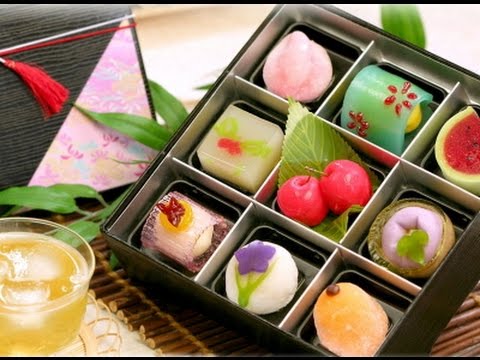Wagashi. Video recipe
Japanese sweets wagashi amaze Europeans with their exquisite, unusual beauty and unusual taste. These are small desserts, more like sweets in the Western sense. There are several types of wagashi, they can be made from beans, fruits, plants. There are sweets that are traditional for different seasons.
Traditional Japanese sweets wagashi. Views
There are about twenty different types of Japanese wagashi desserts. Some of them have their own subspecies. The Japanese dessert mochi has the most varieties – “koloboks” made from boiled and mashed Japanese rice. Making traditional mochi is a laborious process. Peeled glutinous rice is soaked overnight, then pounded with special wooden hammers.
One pair of hands is not enough to make a sticky paste; someone has to constantly wet the rice. The second traditional ingredient in Japanese desserts, anko paste made from adzuki beans, is often used in mochi sweets. So daifuku is mochi stuffed with anko. Rice la mochi seasoned with wormwood allows you to sculpt green kusa mochi, if you put bean paste in such a “bun”, then the name of the sweet will sound like emogi daifuku. Kagami mochi, literally translated as a mirror rice cake, is a traditional New Year’s sweet, consisting of two round “koloboks”. The little mochi on a stick are called dango. If you dilute anko pasta to a soup state and put mochi in it, you get another traditional Japanese dessert – zenzai.
Mochi ice cream is very popular in Japan – with sweet rice on the outside and cold sweetness on the inside. Ice cream can be vanilla, chocolate, green tea, or red beans
Anko paste spread between two crunchy rice crackers turns into wagashi monaka, and if you cook rice cakes with bean paste and wrap them in pickled cherry leaves, you get a sakuramochi dessert. Uiro is a steamed rice flour cake.
Wagashi anmitsu turns out to be very beautiful – dense jelly made from agar-agar with fruit, one of the oldest Japanese desserts, yokan, is made from agar and anko, it looks like a marshmallow. The sweets ame and kinkato resemble caramel sweets, and amanatto are similar to them – boiled dried beans in a sweet glaze. One of the simplest and most familiar wagashi in the European taste – shogato, is simply pieces of candied ginger.
Wagashi are divided into types, guided by their moisture content. So namagashi – wet desserts, more than 30%, han namagashi contain from 10 to 30% moisture and Higashi – dry sweets, less than 10% moisture
The Japanese say that in order to learn how to cook wagashi, you need to spend at least 12 years learning all the subtleties. And the ingredients for such sweets in Russia are not easy to buy even in large cities such as Moscow or St. Petersburg, but you can try to cook something simple. For example, try the traditional delicacy of the people of Kyushu, the karukan. You will need: – 90 grams of yam; – 140 grams of granulated sugar; – 100 grams of rice flour; – ¾ teaspoon baking powder; – ½ tablespoon of dried wormwood; – 2-4 tablespoons of water.
Peel and grate the yam tubers. Mix with granulated sugar, add one tablespoon of water and a full. Let stand for a few minutes and add sifted rice flour and baking powder. Knead the dough, adding water a little at a time. Line the steamer with parchment paper, lay out the dough and steam the sweetness for 15-20 minutes. Let the finished wagashi cool and then cut into small pieces.
For an interesting naughty look with boyfriend jeans, read the next article.










